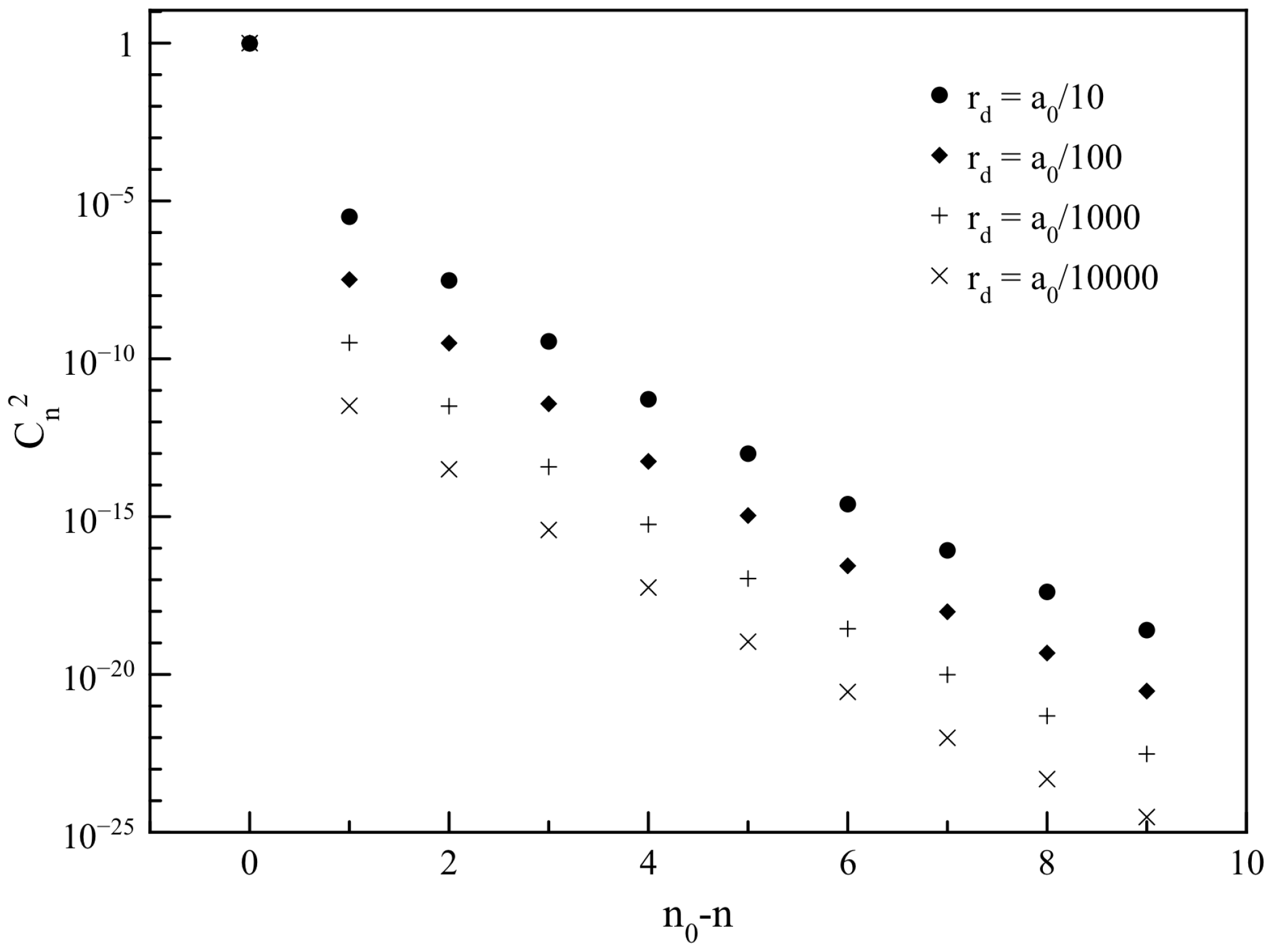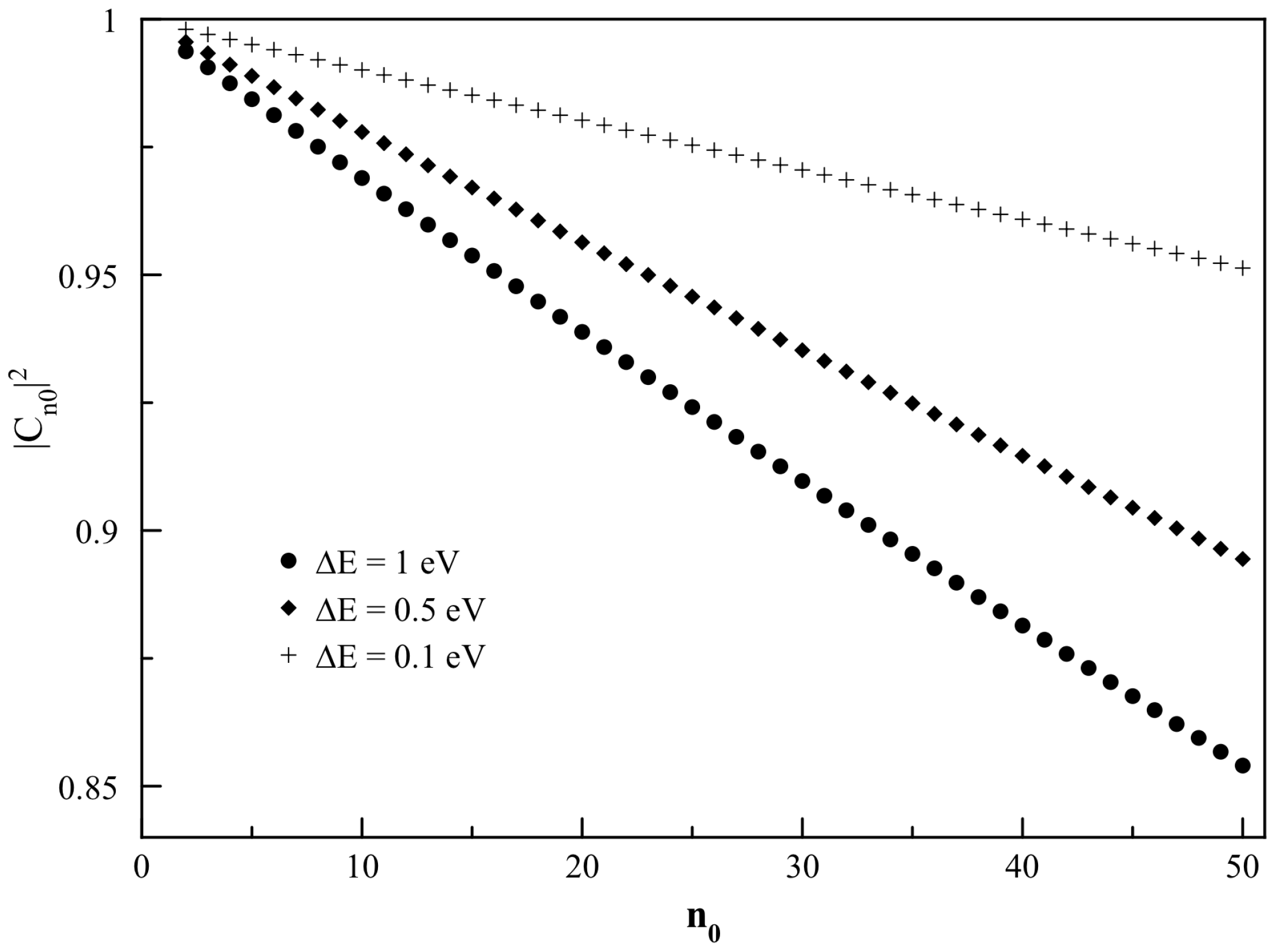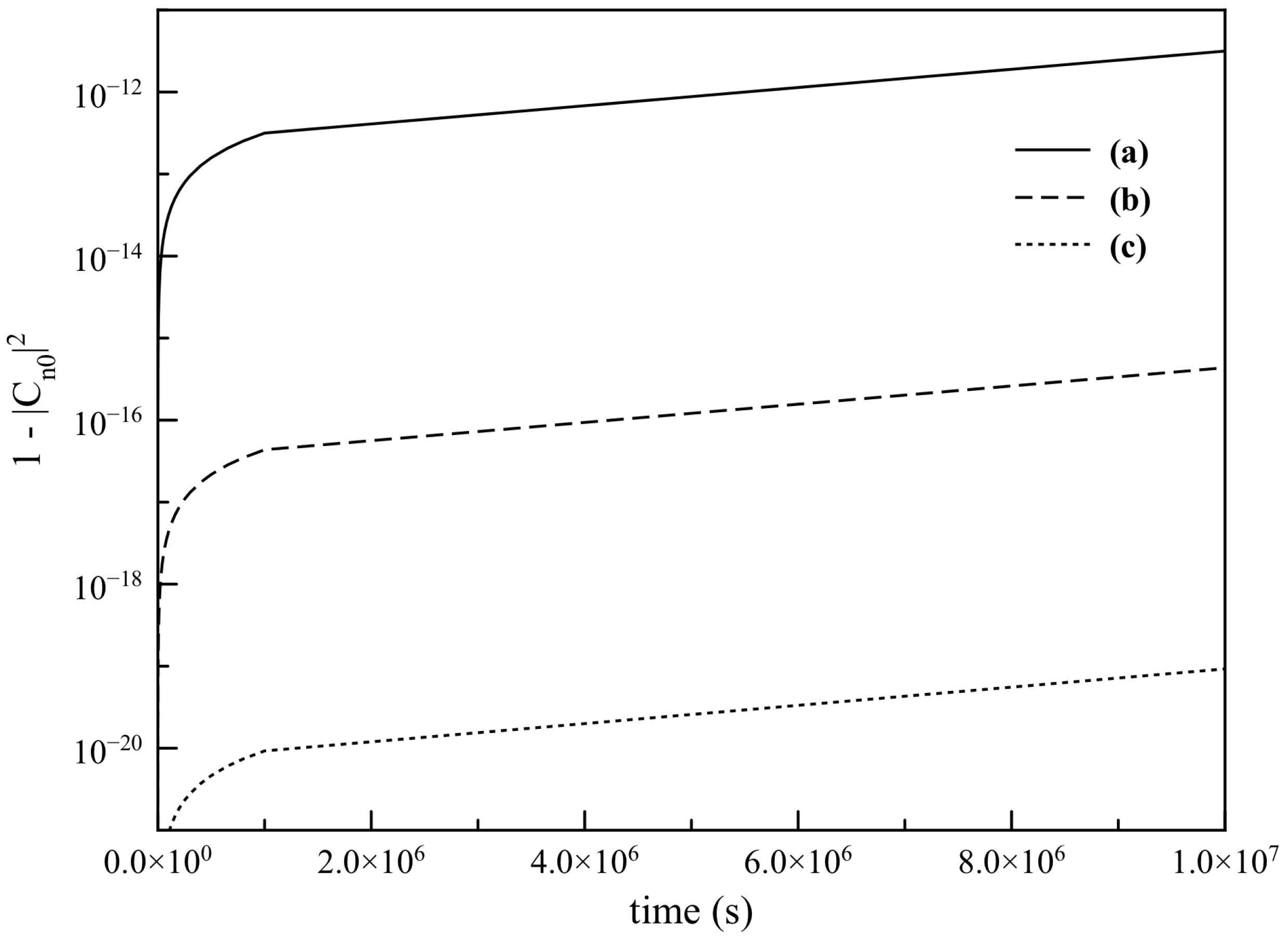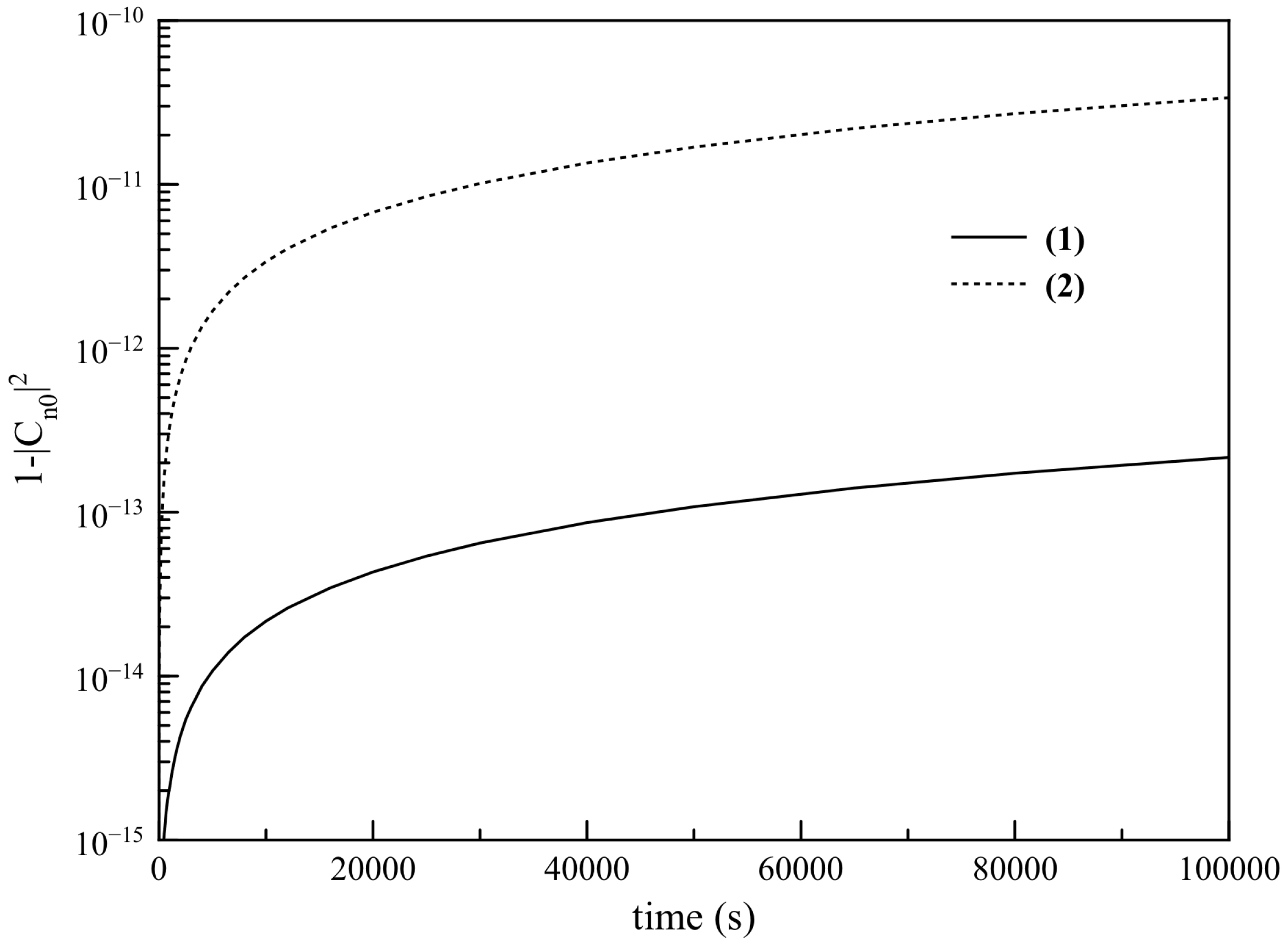1. Introduction
Current experimental techniques have allowed the manipulation of atomic systems to previously unthinkable degrees, paving the way to the development of new technologies and the observation of very small quantum effects. One such technology is the quantum computer; trapped-ion systems have been implemented successfully to perform logical operations [
1,
2,
3], making atomic systems a strong candidate for scalable quantum bits. Furthermore, the implementation of highly excited states (Rydberg atoms) has been proposed for quantum computing because of the length of their interaction and their long coherence times [
3,
4,
5,
6]. In order for atoms to be suitable for quantum technologies, it is necessary for them to have long coherence times, which is ultimately limited by their interaction with environmental particles [
7]. In this paper, we propose a new decoherence mechanism of excited atomic systems induced by particles through short-distance interactions. This not only presents a fundamental limit to the stability of atomic systems, but can also be applied to the detection of weakly-interacting particles by means of analyzing the evolution of the atomic state. A search for exotic interactions using the decoherence of a Ramsey interferometer has been suggested previously [
8,
9], but the mechanism for linking the decoherence of internal degrees of freedom of the atom (energy levels) with momentum transfer was left open.
In our work, we propose that when a particle is scattered by the atomic nucleus it will produce an almost instant change in the position of the nucleus, which will be perceived by the electron in the atom as a sudden change in the electrostatic potential, projecting the wave function of the atom into the eigenstates of the new potential. First, we calculate the change in the state of the atom as a result of the nuclear displacement, obtaining a projection over lower energy levels only. We then express the order of the displacement in terms of the properties of the nucleus and the scattered particle, observing that the effect is more prominent for Rydberg atoms. Finally, we extend the analysis to multiple scattering events and analyze the evolution of the state of an atom scattering photons and massive particles.
2. Decoherence by Scattering
A particle scattered by a nucleus will transfer some of its energy, causing a displacement of said nucleus. We suggest that if the translation of the nucleus is done in a very short period, the electron of the atom would not be able to follow the movement smoothly, resulting in a change of the internal state of the atom. The perturbation is presumed to be small enough so that no ionization will occur; any higher energy transference will not be accounted for by our model. As a result of the nuclear displacement, the electron will experience a sudden change in the electromagnetic potential, so its wave function will be projected into the eigenstates of the “new position” of the atom, in accordance with the adiabatic theorem [
10].
Let
represent an eigenstate of the atomic system and
represent the state of the atom after the nucleus has been displaced along the vector
. The state of the atom after the scattering can be expressed as a superposition of eigenstates as
where the coefficients
of the spectral decomposition can be calculated as
This equation can be very difficult to solve, depending on the atomic system. To simplify the calculations, we take some considerations and approximations that are described below.
First, we only consider initial states of the atom with no angular momentum. For atoms with just one electron in its last orbital—which are commonly used for atomic trapping [
11,
12,
13]—we can approximate the wave function as that of the hydrogen atom by adding a correction term to the principal quantum number [
14]; this approximation is especially accurate for Rydberg atoms [
15].
Due to the stochastic nature of the particle scattering, it is not possible to know the direction of the displacement. Because of this, rather than consider a displacement along the vector
, we will consider a delocalisation of the nucleus within the radius
. With these considerations, the wave function after the collision will be given by
where
is the associated Laguerre polynomial,
is the Bohr radius, and
is the principal quantum number of the atom before the collision. The approximation in Equation (
3) assumes the wave-function preserving a spherical symmetry after the collision, which restricts the interactions to those in which there is no exchange of angular momentum between the particle and the nucleus.
By algebraic manipulation of Equation (
3), we get the expression
with
. By using this identity in Equation (
2), and since the eigenstates
are orthogonal, the coefficients of the decomposition can then be calculated as
This expression tells us that there is no excitation of the atom, but rather a projection over the initial state () and lower energy levels ().
In
Figure 1, the coefficients of the decomposition are plotted for different values of the displacement distance, illustrating the distribution of the wave function after the interaction. Here it is shown that the coefficients of lower-energy states increase with the displacement of the nucleus, which is expected because the effect should be more prominent with higher perturbation. It can also be appreciated that the coefficients decay very rapidly as their associated principal quantum number draws away from the quantum number of the initial state.
Next, we calculated the order of the perturbation as a function of the proprieties of the scattered particle.
3. Function of the Perturbation
The term
is determined by how much the nucleus moves before the electron perceives its displacement. We estimated this quantity by taking the product of the velocity
that the nucleus gains by the scattering multiplied by a time
τ; this period should be small enough to consider the change in the potential as non-adiabatic. For this time, we considered the period of the production of photons which carry the electromagnetic force between the nucleus and the electron, given by the equation
where
μ is the reduced mass of the atom,
is the mass of the electron,
is the Coulomb’s constant, and
e is the elementary charge constant. It takes this time for the nucleus to “send information” to the electron about its position. The velocity of the nucleus is given by the energy
it gains as a result of the scattering,
where
is the mass of the nucleus. Using Equations (
6) and (
7), we get the displacement distance
To give an idea of the order of the displacement, a cold neutron (kinetic energy of 0.025 eV) scattered by the atom will result in a displacement distance of
0.1, according to Equation (
8); other interactions presented in this paper will result in displacements of the nucleus several orders of magnitude smaller. Using Equation (
8), we obtained that the coefficient of the initial state
after the scattering (Equation (
5)), will be given by
Using Equation (
9), we generate the plot in
Figure 2 of the value of
as a function of
for different energies transmitted to the nucleus; all used energies are below the ionization energy of the atom.
It is observed that the magnitude of
decays with the value of
, meaning that it will be more probable to find the atom in a state other than the initial if we prepare the atom in a highly excited state (Rydberg state). This result is reasonable, because states with high energy are more susceptible to perturbations by collision [
16,
17]. For our model, it can be argued that atoms in a high energy level have more possible states to decay to, and that the states have closer energy, which increase the probability of transition as a result of the interaction.
If we take interactions with angular momentum exchange into account, this would increase the possible decay channels, further decreasing the value of
. By performing the same calculations as in
Section 2 for a non-spherical symmetric wave function (
), it can be obtained that the probability of transition to a state with
will be
, which is similar to the transition to a state with
given in Equation (
5); the change in the initial state for this case will be several orders of magnitude bigger than the calculated in Equation (
9), so the studied model will correspond to the lower bound of the possible observable effect.
4. Temporal Evolution
It can expected that the atom will scatter multiple particles as time passes, so we calculate the coefficients of the decomposition after a given number of interactions. An atom with an initial state
will evolve into the state
after a single scattering. When a second scattering occurs, the atom will change into the state
, assuming an interaction of the same order as for the first scattering and that the state of the atom does not evolve between collisions; any time dependence between consecutive collisions will increase the overall decoherence. The eigenstate decomposition of the state
is calculated following Equations (
1)–(
5), resulting in
Here we have that the coefficients are given by
We then calculate the coefficients for the state after a third scattering
, using the same logic as for the state
, and so on until we calculate the coefficients for an arbitrary number of interactions. The resulting general formula that gives the coefficients after a given number of particle scatterings is too long and complicated to be shown in this paper. As we have previously indicated, the coefficients decay very rapidly as its principal quantum number goes farther from the number
(
Figure 2), so we focus our attention on the coefficient of the initial state
and the eigenstate one energy level lower
; after
l number of collisions, these coefficients are given by
The above calculations assume that the collisions are statistically independent. This approximation is accurate for our model because the probability of interaction is expected to be very small, so enough time will pass between two collisions to neglect any correlation [
16]. Additionally, it will be seen below that very long times are necessary to observe the proposed effect, further validating the approximation.
It is important to call attention to Equation (
13); here we have that the coefficient
is not an exponential function of the number
l (which is time-dependent, as shown next). An exponential dependency of the time is typical for the effect of other sources of decoherence, like energy relaxation of the electron [
18]. This difference will allow the effect to be distinguishable over other mechanisms of decoherence. Another important remark is that, because of the dependency of
, the change in population in the atom’s energy levels can be modulated by using a different initial state, which is useful for experimental observation.
To estimate the number of collisions over time, we consider only short distance interactions between the particles and the nucleus. The number of collisions in a period
t is given by
where
σ is the effective cross-section,
is the flux of particles, and
t is the time. By substituting this expressions in Equation (
12), we obtain the time evolution of the coefficient
.
We proceed to estimate the magnitude of the decoherence, first for the scattering of photons and then for the scattering of particles with mass.
4.1. Photon Scattering
An alternative form of Equation (16) that is useful to calculate the number scattered of photons is
where
is the energy density of the electromagnetic radiation,
c is the speed of light, and
ν is the light’s frequency.
For low energy photons, we consider Thomson scattering by the atomic nucleus, which gives the cross-section
The same formula can be applied for photon scattering by the electrons of the atom; because of their small mass, we will disregard this interaction in our calculations. The average change in the energy of the photon, given in the rest frame of the nucleus, is
Using Equations (
15), (
17), and (
18), we finally arrive to the function
With this formula, we calculate how the state of an atom differs from its original state as a function of time for different energy densities of radiation surrounding the atom (
Figure 3).
The analyzed energy densities correspond to (a) the solar radiation on the Earth’s surface, considering a constant insolation of 52.2 PW (
MeV/cm
) [
19], (b) the environment of an AMO laboratory with the ambient lights turned on, given a measurement of 4
W with a detector of 9.5 mm in diameter (
KeV/cm
), and (c) the cosmic microwave background (
eV/cm
) [
20]. These cases represent common circumstances for atoms to be exposed to, and cover a fair range of energy densities. The time scale of the plot comprise periods that are much larger than the radiative lifetimes of Rydberg atoms [
21]. In experiments, it should not be expected to directly see the loss in population due to the proposed effect, but rather a deviation in the decay curves due to spontaneous emission and other known perturbation sources. The effect of the photon scattering is shown to be very small—even for the most energetic radiation—but its contribution can be relevant for ultra-precise metrology.
Other studies have analyzed the decoherence induced by the scattering of non-resonant photons, but they are based on the localization of the atom by the scattered light ([
7,
22]). In these studies, the interaction of stochastic radiation is ignored, which is covered by our model.
4.2. Massive Particle Scattering
For the scattering of a particle with mass, we consider the interaction as a direct collision between the particle and the nucleus. The energy transferred to the nucleus for a scattering event at the most probable angle is given by
where
and
are the mass and the velocity of the scattered particle, respectively. With this formula we have that the coefficient of the initial state evolves as
We use this formula to calculate the state of an atom continuously scattering two different kinds of neutral particles (
Figure 4).
We analyze two particular cases that we consider to be the most significant in terms of limiting the stability of atomic systems: (1) The scattering of neutrons, and (2) the scattering of Dark Matter. In case (1), we consider neutrons from secondary cosmic rays having a flux of
neutrons per second per square meter, a cross-section of
barn, and a kinetic energy of
GeV [
23]. In case (2), we analyze the local distribution of Dark Matter with a reported density of
kg/m
[
24]. We assumed that Dark Matter is thermalized by the background radiation (
K) and that it is composed of Axions, with a mass of
eV/c
and a cross-section of
barn [
25,
26]. For experimental observation, all axion–electron interactions can be excluded, as they will result in excitation or even ionization of the atom [
27,
28].
The decoherence by massive particle scattering is observed to be more prominent than for photon scattering in both cases. This means that the scattering of cosmic rays could impose the ultimate limit to the stability of excited atomic systems.
It is remarkable that the particular case of local Dark Matter we analyzed will perturb the atoms to a higher degree than the cosmic rays. This presents the possibility of applying our theory to the detection of such particles, or to set a limit to their mass, by analyzing the coherence in highly stable atomic systems, like the hydrogen maser [
29,
30]. The interaction of exotic matter has already been modeled as a s-wave scattering, with the proposed method of detection very similar to ours [
26].









